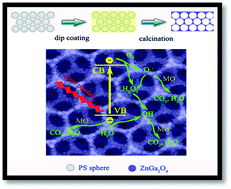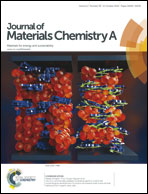A facile preparation of ZnGa2O4 photonic crystals with enhanced light absorption and photocatalytic activity†
Abstract
Photonic crystals of multiple metal oxides with highly ordered structures and unique photonic effects have presented a prospective application in designing of photocatalysts. In this study, a facile method was developed to prepare pure ZnGa2O4 photonic crystals with a highly ordered skeleton structure at a relatively low temperature (500 °C). Due to facilitated mass transport in a highly ordered channel, the as-prepared ZnGa2O4 photonic crystals exhibits better photocatalytic activity towards methyl orange degradation compared to those of porous ZnGa2O4 and ZnGa2O4 nanocrystals. By changing the pore diameters in the structure, a slow photon effect on the blue edge of photonic band gap could be observed, which consequently enhanced the electronic band absorption over ZnGa2O4 photonic crystals with a pore diameter of 180 nm, and further improved their corresponding photocatalytic activity. Furthermore, the degradation mechanism over ZnGa2O4 photonic crystals was discussed. The preparation of ZnGa2O4 photonic crystals in this study provides experimental guidance for developing ternary metal oxide photonic crystals with enhanced light absorption and photocatalytic activities.


 Please wait while we load your content...
Please wait while we load your content...